All about pruning apple trees
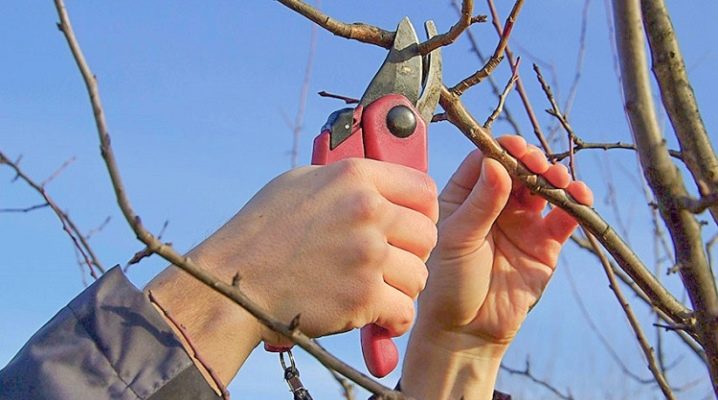
Every gardener who grows apple trees on his site must master the technique of correct pruning. If you carry out the procedure without proper knowledge, then you can not help, but harm the plant. It is competent pruning that is one of the main elements of caring for fruit trees. Such plants bear fruit regularly and show high yields.

The need for pruning
Top shoots or tops are removed first. Too much shading inside the crown or on the lower branches is harmful. Lack of sunlight will reduce flowering and weaken branches. Pruning improves air circulation and reduces the incidence of pests and diseases. During the procedure, dead and diseased shoots are removed. Moreover, the formation of a low crown makes it easier to access it during harvest. Weak thickening contributes to the formation of larger fruits.
A tree overflowing with fruit produces fewer quality fruits during the season. One apple tree has a limited amount of resources. The fruits on the branches divide them among themselves.
Fewer apples means that everyone gets more resources to grow. More fruit means fewer resources available to everyone, resulting in fewer apples.


When to prune apple trees?
Late winter or early spring, when the tree is still dormant and before active growth begins - the best time to prune apple trees. The buds are easier to see and bypass, and the wounds made will dry out before the insects appear in the spring.
Pruning too late reduces winter hardiness to a small extent, making the tree susceptible to winter cold. In summer, the procedure can be carried out at the end of July or August, in autumn - after harvest.
Young
After planting, young seedlings should not be touched at all until they reach one year of age. In Siberia, in the Leningrad region and in the Urals, it is preferable to sanitize trees in early spring, but one should always remember about recurrent frosts and be wary of them. Be sure to carry out the procedure before the start of sap flow. Four-year-old trees are pruned in early fall or early spring.
If the first option is chosen, then this should be the period of the end of the growing season, when all the fruits are harvested, and the foliage is already all opal.

Old
A large old apple tree has more resources to restore. A five-year-old tree can also be pruned in early spring to thin out the crown, remove diseased and weak shoots, as well as those that have not survived the winter and have dried up. It is necessary to refresh the tree as much as possible so that its resources in the future or current season are spent on the formation of only healthy branches and fruits.

Required tools
A mature apple tree has branches of different sizes, so you need several tools to help you get the job done efficiently.
- You can't do without a secateurs. Such a hand tool is small in size and fits comfortably in the hand. Use pruning shears when pruning small branches that are easy to reach. They have two different cutting mechanisms: bypass and anvil. Bypass pruning shears are better for cutting live branches, anvil pruners for dry ones.
- Special scissors are also useful. They do an excellent job with small to medium sized shoots.With their help, you can reach the branches that are located above the growth of the gardener. Long handles are very convenient, plus - such units easily cope with thick branches that the pruner cannot handle.
- A saw is suitable for large, thick branches... It will help to remove the second barrel if it has already formed enough, but has begun to interfere. It is important that the instruments are sharp and clean. Smooth cuts heal quickly, so it is not advisable to leave jagged and rough edges.
- Before pruning, the tools are dipped in isopropyl alcohol and allowed to air dry. Thus, the gardener disinfects the metal. The saw must also be pre-processed, for this moisten a clean cloth with isopropyl alcohol and carefully wipe its blade.
This treatment prevents the transfer of any fungal diseases from tree to tree.
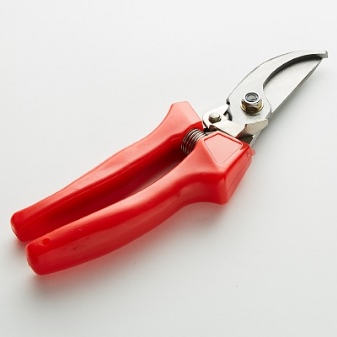

Views
There are many types of apple pruning. Sometimes the top and long, thick unnecessary branches are removed, and sometimes only dry and diseased shoots.
Sanitary
High or low apple - sanitary pruning is done in both cases. It is especially relevant if it is a multi-stem tree with a large number of branches. Such apple trees are especially demanding to care for. Professional pruning is not available to everyone, but you can learn the technology and learn it yourself. The time for sanitary pruning is late autumn. It is necessary to remove the lower and diseased branches, as well as those that have begun to dry. A neglected fruit tree will not produce quality fruit as it will often get sore.
During the procedure, branches are removed to healthy wood. If necessary, then you can repeat pruning in early spring, before budding begins. Sometimes the removal of broken branches may be required in winter, if they cannot withstand the weight of the snow and break off.

Formative
You cannot do without crown formation while caring for an apple tree. Pruning is done in the first year after planting. If you skip the procedure, then the freely growing crown will cause a lot of inconvenience in the future. She has many flaws.
- Such an apple tree is very thickened, so there is insufficient ventilation inside the crown and there is not enough lighting. All this is not conducive to the development of the fruit tree, the likelihood of the appearance of diseases and insect damage increases.
- Such growth is difficult to control, the tree becomes too large, and it is inconvenient to harvest the fruits. Skeletal branches begin to develop separately, unnecessary forks are formed. In this case, the crown becomes brittle, the shoots can easily break off under the weight.
- Can form several trunks at once, which is unacceptable when the gardener wants to get a quality crop.
- Branches grow chaotically which causes a lot of inconvenience when organizing apple tree care.
Formative pruning is different, each type should be considered in more detail.

Sparse tiered
This type of tree shaping has been used for a long time.... It is considered a classic. Used for tall apple trees. When pruning, two or three tiers of skeletal shoots are created. The crown is formed within six years from the moment the tree was planted. For each tier, you need two years of pruning.
The stem is laid at a height of 40 to 60 centimeters. The stem is understood as the stem part that goes from the root collar and ends with the base of the skeletal shoot. The number of skeletal branches is from 1 to 3. Be sure to cut them in such a way that they are in different directions. This way, the branches do not interfere with each other. When the crown seems too liquid, two more are left on such shoots, which are considered to be of the second order. This is ideal for tall varieties.
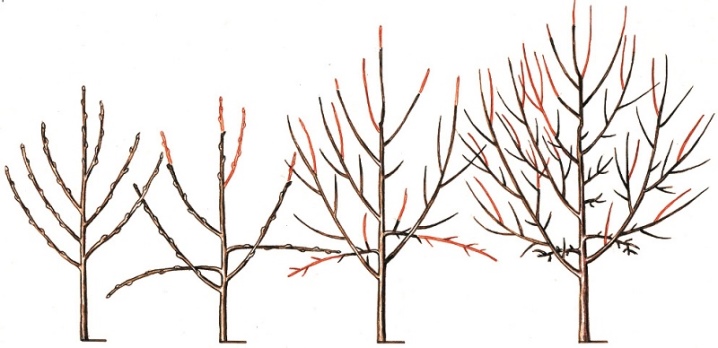
Cupped
The name is fully consistent with the form. This type of pruning is gaining more and more popularity. This type of pruning is suitable for low and medium-sized apple trees. With this kind of trimming is ensured.
- Good crown control.
- Optimum illumination of all branches can be achieved.
- Good ventilation.
- It is convenient to take care of the apple tree and harvest the fruits.
There are two bowl type:
- simple;
- reinforced.
In the first case, the shoots on the crown are located at the same level. In the second, there is a distance between them. Experts advise using the second type, since it allows the branches to withstand a heavy load. To give the tree such a shape, you must first cut the seedling at a height of 60-80 cm. The next year, you will need to choose the 4 strongest ones from the shoots formed. It is imperative that they are located at a distance of 10-15 cm from each other and grow in different directions.
It is they who will become the skeleton of the crown in the future. Over time, they are removed by 50%, and all other shoots are completely removed. With such pruning, increased formation of shoots on the sides and tops begins, and the crown thickens. In the future, annual pruning is performed, since it is important to ensure that the branches that are skeletal are of the same length. In no case should any of the branches take on the leading role and begin to form in the form of a trunk.

Spindle
This form of pruning is more common in large gardens. It is applicable on dwarf and subdwarf rootstocks. The stem is formed with a height of about 50 cm, while the apple tree itself should be 2.5-3.5 meters high. The crown is obtained in a girth of 3.5 to 4 meters.
To carry out such pruning, you must first remove the shoots and buds from the seedling before planting it to the height of the trunk. The central trunk is cut to 80 cm, if the plant is annual, and if it is biennial, then up to 100 or 120 cm. After a season, 7 branches are left on the lower tier, which must be tied horizontally to stop subsequent growth. All unnecessary things are removed from the tree. The procedure is repeated for several more years, each time a new tier is formed.
As soon as the required height is reached, the central trunk is cut off.

Superspinning
This method will differ from the previously described method by a smaller crown diameter. Suitable for compact planting of seedlings. The formation process follows the same scheme, only the central trunk is not cut off. With this form of pruning, it is better to use a stake or trellis as a support for the tree.

Weeping form
This shape is used for decorative purposes. You can use a weeping apple variety or graft a stem on a regular tree to achieve the desired effect. Among the varieties that have a similar feature: "Bratchud", "Junga", "Vydubetskaya"... Trees of these varieties show good winter hardiness.
In addition to edible varieties, there are ornamental trees, the fruits of which are not suitable for food. Unfortunately, it is not always possible to get such a seedling, so you can reverse graft the tree on the tree. In this case, the apple tree is grown up to two meters in height, with a stem. At this level, 4 cuttings are grafted to it in a lateral incision and always buds down.

Stance
This type of crown is suitable for plants that are grown in harsh climates. This form makes it possible to shelter trees for the winter. Pruning begins from the moment the seedling is planted. Creeping apple varieties are ideal for this crown.
The stem is made at a height of no more than 20 centimeters, since the tree itself will not be more than 50 cm. Above it there are 4 skeletal shoots, which should be ridge or cross in relation to each other. The branches of the first and second order will constantly need to be pinned to the ground, the rest can grow freely.

Rejuvenating
This type of pruning is necessary for old apple trees. The procedure allows you to restore a high level of fruiting and extend the life of the tree. Pruning is carried out every five years - starting from the moment the apple tree turns 10 years old.
In this case, old shoots are removed, which are skeletal. The trunk is shortened, thereby reducing the height of the crown. Inside, the volume of shoots is also thinned out. When the tree has grown a lot, so as not to harm it, the procedure is carried out in several stages over three years.

Regulatory
By regulating, we mean such pruning that allows you to reduce the internal volume of the crown in order to improve ventilation and illumination in the branches. It is made in early spring and can be combined with other types of pruning. Be sure to remove all shoots that grow inward, spinning tops and intersecting. A sense of proportion must be observed in everything, and this procedure is no exception.
To avoid damaging the tree, do not remove too many shoots.

Basic ways
Apple pruning can be ring, bud, or staged.
On the ring
For novice gardeners, I would like to recommend the principle of pruning into a ring.... The tree has a so-called cambial ring on each branch. It is sometimes well pronounced, and sometimes not at all visible. The cut is carried out along it. If it is not visible, then trimming is done along the bisector of the angle located between the trunk and the conditional line that should pass perpendicular to the axis of the shoot to be trimmed.

On the kidney
There are several options for execution:
- to the internal;
- to the outside;
- on the side.
The direction of growth of the shoot, which will then appear from the left kidney, will depend on the chosen method. So easily the volume of the crown increases or decreases.

Phased
Phased pruning is carried out when you need to redirect the shoots in the right direction. This pruning is done in several stages. First, a branch is found on the shoot, which should be directed in a different direction, and a cut is made above it. Thus, in several years, you can create a crown of the required shape.
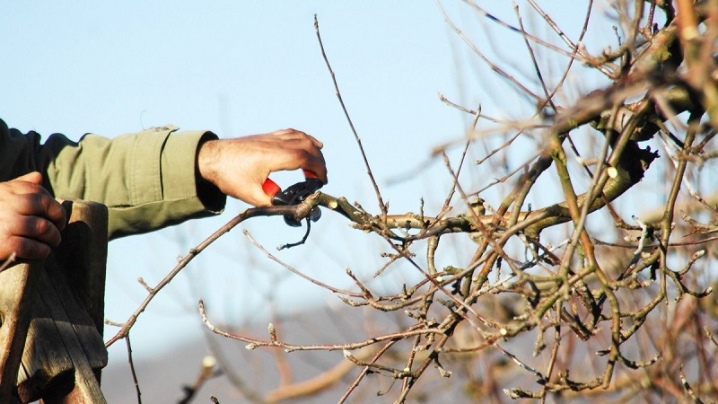
Step-by-step pruning instructions
In order not to harm the tree, it is necessary to cut it correctly, do it on time and use the scheme. For each period, there are rules on how to form the crown of fruit trees.
Spring
Pruning in early spring has its own characteristics, it is carried out to prepare the tree for the new season and eliminate the effects of winter. Usually this is a sanitization of the crown, during which it is not enough just to cut an unnecessary branch, it is necessary to remove all damaged and diseased shoots.
It is completely necessary to remove branches affected by various kinds of infections, insects, burnt and frostbite, since they will only draw on moisture and nutrients, but will not bear worthy fruits. All shoots located inside the crown must also be removed in the spring. It is easy to identify the extra ones, since they are at an acute angle with the trunk. This way you can easily rejuvenate old apple trees, but the main thing is not to overdo it so that the tree does not get sick. Only when absolutely necessary, a strong or medium pruning is carried out with the formation of a crown.
With this procedure, it is easy to regulate the number of apples on the tree. There is one peculiarity of planting buds in apple trees. If one year she gives a lot of fruits, then the next season will not lay a large number of flower buds, and vice versa. When the tree has been resting for a year, there will be many flower buds for the next season, so strong regulatory pruning is imperative.

Summer
You can also prune in the summer.... You can do it in any month. Pruning the fruit tree strongly during this period may be required only after a hurricane, when the branches are broken, but I want to save the apple tree. If some shoots were not visible that they are sick in the spring, then they can be removed in early summer. At the end of June, strongly growing green shoots are pinched. This must be done, since they take food from the skeletal branches, respectively, the apples grow on them small. Moreover, too abundant accumulation of such shoots leads to unnecessary shading of the crown.
If a branch is cracked or broken in the summer, you can cut it off at any time. By the end of the summer season, shoots are harvested that did not have a lot of fruits, since they do not allow light to reach young branches, on which the yield is higher. At the end of the summer season, processing is carried out in order to slow down the growing season for the next season.
In the absence of diseased and broken branches, during summer pruning, you can limit yourself only to the removal of shoots, which greatly thicken the crown.

Autumn
If you did not have enough time to carry out high-quality pruning of the fruit tree in summer or early spring, then you can finish it in the fall. During this period, a few weeks before the expected frost, sanitary, forming pruning is carried out.
Sick, cracked, affected shoots, as well as those that interfere and make the tree too thick in the crown, are removed. It is good to carry out anti-aging pruning during this period, which will allow you to get more apples for the next season.

Winter
In general, they try not to touch the tree in winter, but it so happens that under the weight of the snow, the branch just broke. Then, of course, it will need to be removed.
Follow-up care
Regardless of what kind of pruning was carried out, after this procedure, careful care of the apple tree will be required. The tree is watered abundantly, fertilizers are applied. If the removal of old branches was carried out in the spring, then they are fed with nitrogen, phosphorus and potassium. Mixtures are used where all three elements are in equal proportions. When removing shoots in the fall, complex mixtures with a high content of phosphorus and potassium are used as top dressing. It is they who help the plant fight diseases, increase immunity, promote quick healing at the site of the cuts, and make the bark strong.
If you give nitrogen, then it will give an impetus for the growth of young shoots, on them before the first cold weather the wood does not have time to ripen, so the tree will not be ready for wintering_ the branches will be frostbitten, more careful pruning will be required in the spring. The proportions are indicated on the packaging for the preparation, they are strictly observed.
A large amount of fertilizer will not do any good, but rather harm. For example, over-intoxication with boron makes the fruits unfit for consumption, despite the fact that they ripen ahead of time.
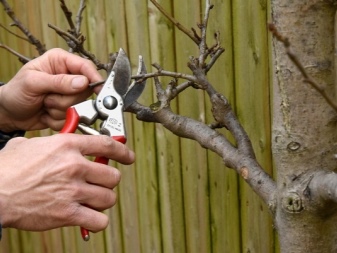

Useful Tips
- The hardest part is to form a pyramidal crown.... Such pruning should be approached only when there is sufficient experience so as not to harm the tree. Before pruning any branch, you need to understand why this is being done. If the gardener cannot answer this question, then it is better not to touch.
- Do not prune when a fungal infection is raging nearby. Any cut, crack is an entrance for infection.
- Before starting the trimming tool it is better to disinfect and repeat the procedure, moving from one tree to another.















The comment was sent successfully.